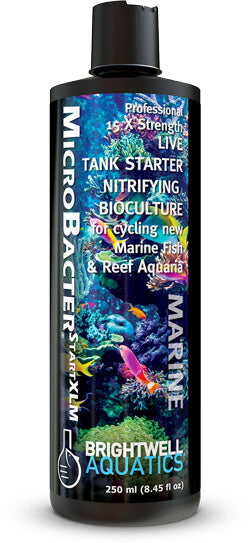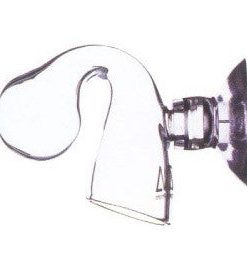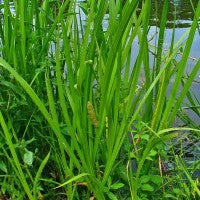Brightwell Aquatics MicrōBacter Start XLM Brightwell Aquatics
$ 30,00 $ 18,00
Professional 15x strength powerful live tank starter nitrifying bioculture, with much fewer temperature and shelf life restrictions than competing products, for rapidly cycling new marine fish and reef aquaria and brackish aquariums, and for recovering from overcrowding or disasters where the bacteria bed has been damaged or when adding new fish. It is also quite useful after re-arranging decorations or performing major maintenance, such as cleaning substrates or biological media to “recharge” the nitrifying bacteria population.
Overview
- Super concentrated 15X Suspension of LIVE non-pathogenic microbes, specifically formulated to extremely rapidly establish biological filtration in new aquarium set-ups, and to enhance the rate of nitrification in existing systems.
- Useful for rapidly re-establishing nitrification bacteria in case of an emergency
- Particularly useful in aquaria with high population densities and when adding new fish
- Helpful to re-establish nitrifying bacteria after cleaning rocks and surfaces and after use of medications.
1. Rapid reduction of ammonia, and nitrite.
2. Prevents “New Tank Syndrome.” - Supplied in a proprietary base which provides for maximum longevity
- Formulated utilizing extensive data compiled by microbiologists.
Description
MicrōBacter Start XLM 15X creates a nitrifying biological filter in marine & brackish aquaria of all types and is particularly useful for new startups, resulting in cycling in about 5 to 7 days in most cases. It quickly removes toxic ammonia and nitrite naturally through non pathogenic nitrifying bacterial action. Even though this product is extremely potent, it may be overdosed at up to 5 times the rated dosage during aquarium emergencies. It should be your first choice to remove ammonia during emergencies where the filter has been inadvertently killed or when experiencing overcrowding.
Technical Background
MicrōBacter Start XLM 15X is a highly concentrated, selective complex of live, extremely effective microbes and enzymes that rapidly reduces the concentrations of organic nitrogen – i.e. ammonia, and nitrite in marine and brackish ecosystems, leading to greatly improved water quality and much faster cycling. Use of MicrōBacter Start XLM does not alleviate the requirement for regular partial water changes to help maintain proper concentrations of elements that are vital to long-term health and survival of aquarium inhabitants.
Notes – It is normal that clumps may form in the product and the product and the aquarium may have an “earthy” smell or smell “off” and the aquarium water could become cloudy and the smell and cloudiness could remain for many hours after using. This is due to the bacteria themselves and is an indication of quality and is the reason it is necessary to shake product well immediately before using.
Pitfalls: Brightwell recommends that you not use any other type of bacteria product until your cycle with this product is complete !!! Do not even use MicrōBacter7 or MicrōBacterCLEAN until the cycle is complete (then you will want to use one of them to help through the “ugly stage”. MicrōBacterCLEAN will work best for this.) Do not use live sand and particularly DO NOT USE dry seeded artificial live rock until cycling is complete. There are no dry bacteria species that will be compatible with this nitrifying bacteria product or that are useful to cycle an aquarium at all! To use a dry bacteria will only lengthen the time it takes to cycle by many weeks and increase your work many times! Wet cycled live rock or even previously cycled wet man made rock will work fine (although this may be a bad idea due to the possibility of introducing parasites or pathogens from another aquarium). Dry sand is fine to use, but not bagged, so called “live sand” because the manufacturer will usually introduce other bacteria species to replace the natural bacteria that will die and these will be counterproductive to your cycle. Also, several so called “probiotic” salts are available. Again, there are no species of bacteria that are conducive to cycling that are available in a dry form. Therefore, do not use any salt that is labelled as probiotic or says it contains dry bacteria.
Storage & Shelf Life: Shelf life is typically 18 months from manufacture date (more than twice as long as any other nitrifying bacteria and 8 or more times as long as most others). Although product can withstand elevated temperatures for short periods of time (a few days), for best longevity and highest potency, keep below 80°F and if possible, it will be best kept refrigerated at 50°F to much prolong shelf life. Do not freeze! Freezing can kill the bacteria. (This product will usually withstand a freeze or two in transit in the winter, but do not freeze, thaw, freeze thaw and keep from freezing if at all possible.) If the product arrives frozen, then thaw at room temperature, NEVER MICROWAVE!
A word about substrates: Most aquarium bacteria and certainly those in MicrōBacter Start XLM live on substrates, that is, they attach themselves to surfaces of rocks, piping and any other surfaces that are available. Most modern aquariums do not have enough surface area. The advent of artificial “live rock” has made available products made from concrete or plastic that look like live rock, but do not have the porosity, so their surface area is too small to support the number of bacteria needed to properly filter the aquarium. Brightwell recommends that you provide plenty of bacterial surface area, either through plenty of porous natural aragonite live rock, or by providing additional filtration media, such as our XportTM media which has the highest surface area per unit volume of any medium in the world, or our less expensive MicroBacter LatticeTM.
Before you get started, you will need:
- An appropriately sized bottle of MicrōBacter Start XLM. At a minimum, you will need 1.2 ml of product for every gallon of aquarium capacity. For example, if you have a 100 gallon tank, you will need a minimum of 120 ml of MicrōBacter Start XLM.
- a good grade of the following test kits: ammonia, nitrite, nitrate, pH
- a bottle of Brightwell Erāse-Cl to remove all chlorine or chloramines (if you skip this, you can kill the bacteria in MicrōBacter Start XLM.)
- Of course, you will need an excellent aquarium salt mix, such as Brightwell NēoMarine and purified tap water. Brightwell recommends the tap water be filtered by Reverse Osmosis with post deionization and that you change your carbon filter regularly.
Instructions & Guidelines
Important: First, use Brightwell Erāse-Cl to completely remove chloramines and chlorine from tap water. Chloramine and chlorine are lethal to the bacteria in this product and if not removed, will cause it to fail! Shake product vigorously immediately before using. Add the appropriate volume of MicrōBacter Start XLM (see below) to the aquarium in an area of high flow to promote dispersion. Do not use “live sand” or “dry seeded artificial live rock” until cycling with this product is complete for several weeks! (In fact, Brightwell recommends that you do not use dry seeded artificial “live rock” ever. The best choices are aquacultured live rock, rock from the ocean, naturally cycled artificial rock sold wet, unseeded dry artificial rock, dry florida aragonite, other natural aragonite, marco rock and the like. Any rock that already contains a bacteria and is dry, will damage the cycling process and in our experience takes too long to cycle and cycles the wrong nutrients – dry seeded rock will not properly cycle ammonia because it is the wrong species of bacteria)
To seed Biological Filtration in new aquaria: Add 30 ml (6 capfuls) of MicrōBacter Start XLM per 25 US-gallons (95 L) of aquarium water. Add one or more hardy fish. Remove filter socks, turn UV-sterilization and/or ozonation and/or protein skimmer off for the complete period of cycling until you are finished dosing this product. Test ammonia and nitrite levels daily or as needed, if either are above .2 ppm, then you can dose MicrōBacter Start XLM again at a lower dose of 10 ml per 25 US-gallons, if desired. At 7 days or longer, Tank is cycled if, and only if, both ammonia and nitrite levels are zero and nitrate is well above zero. If either ammonia or nitrite levels are above zero, then the tank is not yet fully cycled and you should not add fish. if the nitrate is not above zero (at least .25 ppm), then tank is not yet fully cycled and you should not add fish.
To replace bacteria killed by extensive cleaning of substrates and surfaces: Add 10 to 30 ml per 25 US-gallons (95 L) depending on perceived damage to filter bed, and ammonia level.
To replace bacteria killed by medications, overcrowding or emergencies: Add 30 ml per 25 US-gallons (95 L) depending on perceived damage to filter bed. Then add 5 ml per half hour until ammonia levels come down.
To perform a Fishless Cycle: Purchase a bottle of MicroBacter QuikCyclTM to use simultaneously with this product, MicrōBacter Start XLM according to the QuikCyclTM label. Fishless cycling requires both products to be used together. This product will provide the bacteria and the QuikCycl will provide the nutrients.
Ongoing care after the aquarium is cycled: To provide ongoing biological stability to a cycled aquarium: Switch to MicrōBacterCLEAN after tank is fully cycled and one week has elapsed. This will greatly reduce problems during the “ugly stage.” At that point, you can add Reef BioFuelTM to provide a carbon source for the MicroBacterClean, if desired. If you want to switch to MicrōBacter7 the best time will be when the aquarium has been running for 4 to 6 months.
| Size | 125ml, 250ml, 500ml |
|---|
Fast Shipping and Professional Packaging
We can offer a variety of shipping options thanks to our long-term relationship with UPS FedEx DHL. Our warehouse staff will package all goods to our exacting requirements. Prior to shipping, your goods will be thoroughly examined and securely secured. We deliver to thousands of customers every day from all over the world. This is a sign of our determination to be the largest online retailer in the world. Warehouses and distribution centers are located throughout Europe as well as in the USA.
Note: Orders that contain more than one item will be assigned a separate processing time for each item.
Prior to shipment, we examine the items ordered thoroughly before sending the items. Most orders are shipped within 48 hours. The expected delivery time is 3 to 7 days.
Returns
The stock is constantly changing and cannot be fully controlled by us due to the involvement of many different parties, such as the factory and our warehouse. The levels of stock can change at any moment. You may not receive your order once the order has been made.
The policy is 30 days. If it's been longer than 30 days since you made your purchase and we're unable to offer you a complete exchange or refund.
To be eligible for a return your item must be unused and in the same condition as you received it. You must have the item in its original packaging.
Related products
Substrate
Filter Media
RO/DI
Air Pump Accessories
Uncategorized
Bacteria
Maintenance Tools
Bacteria
Freshwater Plant
Plant Fertilisation
Plant Fertilisation
Freshwater Plant
CO2 Accessories
CO2 Accessories
Freshwater Plant
Air Pump Accessories
Bacteria
Filter Media
Plant Fertilisation





































